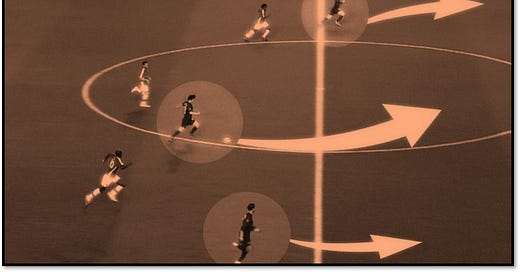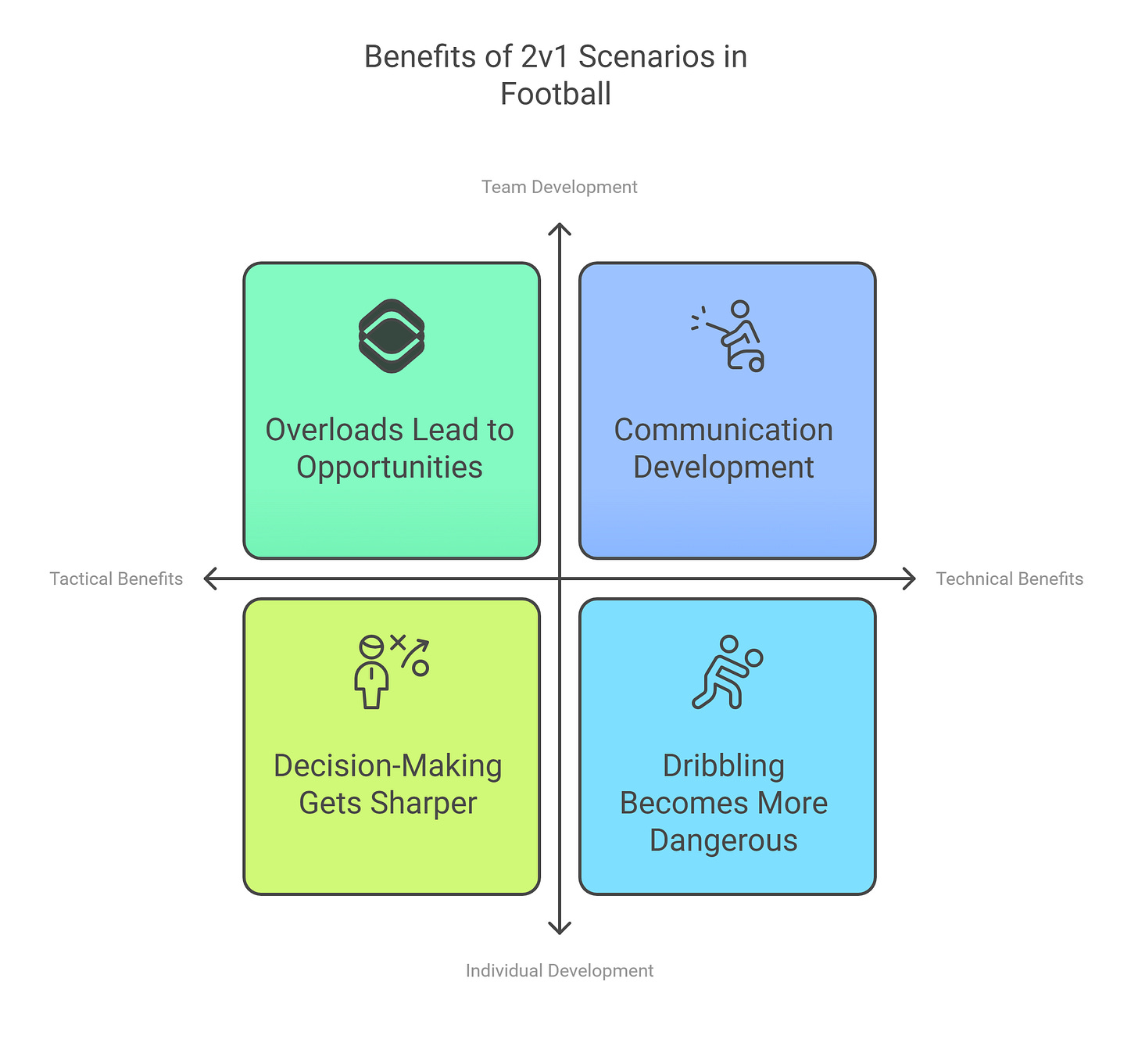Welcome from JustCoachMD. We are happy to have you on board and look forward to providing you with helpful content.
Here is What to Expect:
Coaching Craft: Exploring 2v1 Tactics
Full 60-Minute Practice: 3 x practices to exploit 2v1 moments
In modern football, superiority is everything—numerical, positional, or qualitative. If you can create a 2v1, you have the power to decide the game. — Pep Guardiola
Unlocking the Power of the 2v1: Are You Coaching This Underrated Advantage?
In football, the 2v1 is a critical—but often underused—component of effective training. It presents dynamic challenges that demand technical execution, tactical awareness, and quick decision-making from players.
This article explores the technical, tactical, and physical benefits of 2v1 scenarios, outlines different types, and offers practical tips and drills to help you bring them into your sessions.
Why 2v1 Situations Are So Powerful
2v1 moments are common in real matches—whether it’s an overlapping full-back, a midfield combination, or a winger isolating a defender. Here are the main advantages:
Create overloads in attack
Make dribbling harder to defend
Develop decision-making under pressure
Improve movement off the ball
Enhance support play and receiving under pressure
Give defenders practice in outnumbered situations
Increase communication (verbal and non-verbal)
Place high physical demands on players
These benefits alone should motivate coaches to integrate 2v1s into their regular training cycle deliberately.
The essence of football is creating and exploiting overloads. When you’re in a 2v1, you don’t just play the game—you control it. — Julian Nagelsmann
Technical and Tactical Benefits of 2v1s
Overloads Lead to Opportunities
In match play, overloads like overlaps and underlaps stretch the defence and create spaces elsewhere. If the defender shifts to deal with the extra attacker, gaps open up. If they don’t, the attackers can exploit the numerical advantage.
Dribbling Becomes More Dangerous
With a support player, defenders can’t focus solely on the ball. If they step to the dribbler, they risk leaving space. If they hesitate, the attacker can drive into open areas. The dual threat forces defenders to make tough choices.
Decision-Making Gets Sharper
Players learn to read cues: Is there space to dribble? Can I combine? Where’s the defender? This builds game-relevant awareness and decision speed, especially for the ball carrier.
Off-the-Ball Movement Improves
Supporting players must move with purpose—overlapping, underlapping, offering one-twos—all of which mirror match situations. These actions require timing, technique, and physical sharpness.
Support and Receiving Under Pressure
2v1s create constant interactions: when to offer, when to receive, when to stay on the ball. This reinforces key attacking behaviours such as body positioning, scanning, and movement off the shoulder.
Defending Outnumbered Sharpens Core Skills
Defenders improve anticipation, body shape, pressing angles, and recovery runs. They’re forced to delay, contain, and manipulate play toward the support or touchlines.
Communication Develops
Players must share cues—whether through verbal calls (“time!” or “left shoulder!”) or non-verbal actions like eye contact, gestures, or trigger movements.
High Physical Returns
Small-group formats demand frequent changes of speed, direction, and intensity. Players are forced to work aerobically and anaerobically under game-like conditions.
Types of 2v1 Situations to Train
2v1 Facing the Opponent
Classic scenario where the attacker decides to dribble or pass based on the defender’s position.
Ideal for rehearsing one-twos and body feints.
Defender must delay and angle run to even the numbers.
2v1 with Back to Opponent
One attacker receives pressure with their back to the goal.
Emphasises shielding, setting, and movement to spin or combine.
Great for central midfield or target player scenarios.
2v1 from Wide Areas (Space on the Sides)
The support player starts behind the ball, perfect for overlaps or underlaps.
Forces attackers to read space and make decoy vs combination decisions.
Defenders must use cues to predict and block.
The best players don’t just pass or dribble—they know when to do it. That’s what small-sided, overloaded scenarios teach better than anything else. — Arsène Wenger
Common Attacking Mistakes in 2v1s – and How to Fix Them
Mistake 1: Lack of Tempo
Slow play gives defenders time to recover and close space.
Fix:
Encourage quick ball movement and explosive dribbling. Add time or touch constraints in training to force urgency.
Mistake 2: Poor Decision-Making
Players hesitate or misread cues, leading to lost opportunities.
Fix:
Use guided questions during practice: When is the right time to pass? What does the defender’s body shape tell you? Pause sessions to discuss options and outcomes.
Mistake 3: Ineffective Movement
Support players stand still or take poor angles, limiting the ball carrier’s options.
Fix:
Coach movement based on triggers—like defender pressure or teammate scanning. Reinforce movements that create space and offer passing lanes.
Tips to Coach a Great 2v1 Practice
Keep it fast: Short (≤8 sec) bursts replicate game pace.
Make it game-relevant: Use pitch markings and walkthroughs to connect with match situations.
Maximise reps: Avoid long queues—set up multiple stations or alternate attackers quickly.
Challenge defenders: Add targets to increase intensity and realism when they win the ball.
Rotate roles often: Everyone should experience both attacking and defending under pressure.
Final Thoughts:
The 2v1 is more than just a passing practice—it’s a core moment of advantage in every game. It teaches players to make decisions, combine effectively, and attack space with purpose.
In your next session, challenge your players to exploit overloads, communicate constantly, and defend with intelligence. Keep intensity high and feedback clear.
Let your sessions reflect the reality of the game, and the 2v1 is one of those realities.
A well-timed support run turns an isolated dribbler into a problem the defender can’t solve. That’s the intelligence we try to coach. — Emma Hayes
The Practices
2v1 | Facing the Defender
⚽️ Created On: @SSPlanner
Aim:
Exploit space behind the defender in a 2v1 situation.
Set-Up:
20 by 30 pitch
2 x mini goals 🥅 at one end and a pair of red coned gates at the opposite end
👕Teams: ⚫️s attacking team and 🔴s defending team
How to Play:
Defender (🔴) starts the practice by dribbling into the middle of the pitch, then passes to the attacking player (⚫️), the attacking player (⚫️) passes to the teammate (⚫️).
Once this sequence occurs, the game is live and the two attackers (⚫️) try to beat the defender (🔴), escape beyond the dashed line and score in the mini goals. If the defender (🔴) wins the ball, they dribble through one of the two red gates.
🚧 Constraints:
🏆Reward: 1st time finishes are worth double
👨🏫 Review: The quality of the pass, the timing of the run and the use of disguise
🚫 Restriction: Time limit to score or the defender gets the ball.
2v1 | Pressure is Behind the Attacker
⚽️ Created On: @SSPlanner
Aim:
Breaking fast when presented with overloads.
Set-Up:
25 by 25 space with a 5-yard shaded zone. Each team has a pair of mini goals to attack. Add a coned gate for each team to use as a start point for the practice.
👕 Teams: Both ⚫️’s and 🔴’s are attacking into defending.
How to Play:
This is a fast-paced game of constant 2 v 1 attacks, the ⚫️’s attack first, followed by 🔴’s. The practice continues like this regardless of who scores.
The central players ⚫️ and 🔴 (1) stay on the field all of the time. They alternate between being a defender and an attacker. Each time they receive the ball as an attacker, they must play it back to their teammate before going for the goal.
⚫️(2) starts the practice with a pass into ⚫️ (1). ⚫️ (1) must pass back to the ⚫️(2) before they can combine 2 v 1 against the defender 🔴(1).
Goals can be scored by getting into the shaded zone and finishing into a mini-goal. Defending players score by dribbling back to their start point or by passing into one of their mini goals.
Once an attack is over, roles flip so ⚫️’s now defend and the 🔴’s attack.
🚧 Constraints:
🏆Reward: 1st team to score 10 goals wins the round
👨🏫 Review: Securing possession with back to play and the decision to dribble or pass.
🚫 Restriction: Attackers have 10 touches max to score a goal.
2v1 | The Pressure is on the Sides
⚽️ Created On: @SSPlanner
Aim:
Using overlaps and underlaps to beat the defender.
Set-Up:
30 by 20 pitch space broken into lanes. The central lane is approximately 6 yards, and the outer lanes are approximately 12 yards.
The defending team has an orange scoring zone. The attacking team have an end line and a mini goal.
👕Teams: ⚫️s attacking team and 🔴s defending team
How to Play:
The practice is set up twice, once on the left side of the pitch and once on the right side. The attacks always start at the bottom of the central grey lane, with a pass to the left or right side of the playing area.
⚫️ (1) passes to⚫️(2) who passes wide to ⚫️(5).
⚫️s (2 and 5) attack 🔴 (1). The ⚫️s must dribble over the end line and finish into the mini goal. The defender 🔴 cannot track the ⚫️s beyond the end line.
Once the attack is finished, all players rotate positions, and a new attack starts down the opposite side of the pitch.
🚧 Constraints:
🏆Reward: The first side of the pitch to achieve 5 goals wins the round.
👨🏫 Review: The timing of the run and the release of the ball during the 2v1 moment.
🚫 Restriction: can only score from a cross into the mini goal or a cutback cross for a 1-touch finish into the mini goal.
Football is a game of decisions. Give players repeated chances to make them under pressure, and they’ll start making the right ones. — Carlo Ancelotti
I send this email weekly. If you would like to receive it, why not join a community of like-minded people who love the game of football?
Enjoyed reading this post, feel free to share it with your friends! Or click the button below so more people can discover us.









